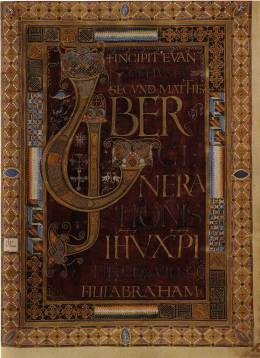The Carolingian moment
This Gregorian midway position represents an essential realignment, which would only slowly gain currency. Frequently restated thereafter, it was not, at the time, followed with much effect. In sharp contrast with the Byzantine world, the issue of figuration was not that controversial in Latin Christendom. Not until the infamous iconoclastic controversy that shook the Byzantine world between 730 and 843 did it rear its head.
The second Council of Nicaea (787) instituted a theology of icons based on positions outlined by John of Damascus[1] who valued images. The interpretation given of them kept no less to the Augustinian canon: as material pointers, memory aids, images may be an object of veneration, but not of adoration. The first versions of the acts of the council, approved by pope Adrian I[2], were met with the consternation and incomprehension of Carolingian[3] scholars who deemed the text an apology of idolatry. Indeed the Latin translation, which gave the two terms of veneration (proskunesis) and adoration (latreia) the same translation of adoratio, blotted out the distinction between them, running counter to Western praxis. At the request of Emperor Charlemagne[4], Theodulf of Orléans[5] drafted an Opus Caroli regis contra synodum (The work of King Charles against the Synod), known thereafter as the Libri Carolini (Charles' Books), which proposed to refute every last point of the acts of the Council and define a Latin position on images.
Outwardly the Libri Carolini kept closely in line with the Gregorian position, that of a midway path on the issue of representation: neither iconoclasm nor adoration. Images may therefore be admitted in churches for decorative purposes with captions to avoid any mistake in identification or interpretation. They must be means to an end, the recall of the high points of a history given as holy. Yet the libri Carolini were careful to recall that this is only a last resort, it has no place among scholars, thereby introducing a radical social and intellectual cleavage: images are memory aids and accordingly suitable only for those who have no way to remember. The Nicaean conclusions were thoroughly refuted. An image should be disconnected from its model, it was to be carefully distinguished from the person represented. The image was never but a fiction liable to lead astray and no substitute for the knowledge of God. Access to God could only be achieved through the “Word”, the “Verb”. The insistence on the Tables of the Law being written not drawn was intended to entrench in no uncertain terms this hierarchy and to affirm the indisputable supremacy of the letter over the image. However, alongside the argumentation adopted to frame a degree of tolerance towards images prefaced with the rejection of their adoration, Carolingian scholars itemized other objects as signposting the divine: relics, for higher clergy the Holy Book and, above all, the cross, the only object, in their view, truly worthy of veneration.
Faced with patent papal hostility the Carolingian court eluded a confrontation: The Libri Carolini were wisely kept under wraps. As a result, since they were not disseminated, they did not amount to a doctrinal reference but rather to an overview of the Latin position with regards to images. Now there is no escaping the fact that all Western figuration practices [doc 11] have honoured this thinking and this tradition. Though images may be present in worship, and be venerated for what they represent, they are not the object of any form of adoration whatsoever. Such positions evinced a Carolingian will to keep to a new via media poised between the rejection of images and their adoration, midway between Byzantine iconoclasm and the Roman Papacy's iconophile stance. This stand led in actual fact to a gradual drift from the Libri's rigid attitude to a deliberate return to the Gregorian tradition. It essentially boiled down to finding the right balance, giving its due weight to the signified, what the image is pointing to. This divesting the image of its sacral charge accounts for the Carolingian period's substantial iconographic output. Beyond places of worship, the splendor of manuscript illustrations [doc 12] contrasts with the Libri Carolini's doctrinal rigor. This latter form of imagery remained restricted to a narrow enlightened circle: the very scholars for whom they were supposedly not intended.

 Informations[6]
Informations[6]
 Informations[7]
Informations[7]
 Informations[8]
Informations[8]





